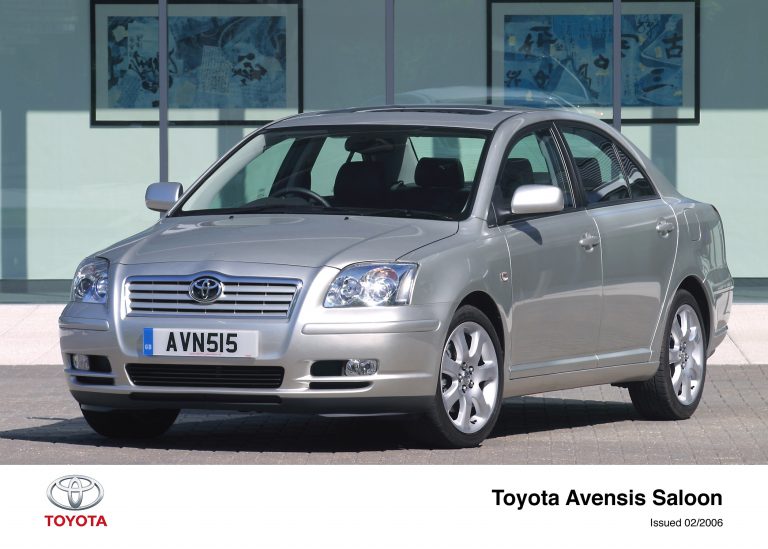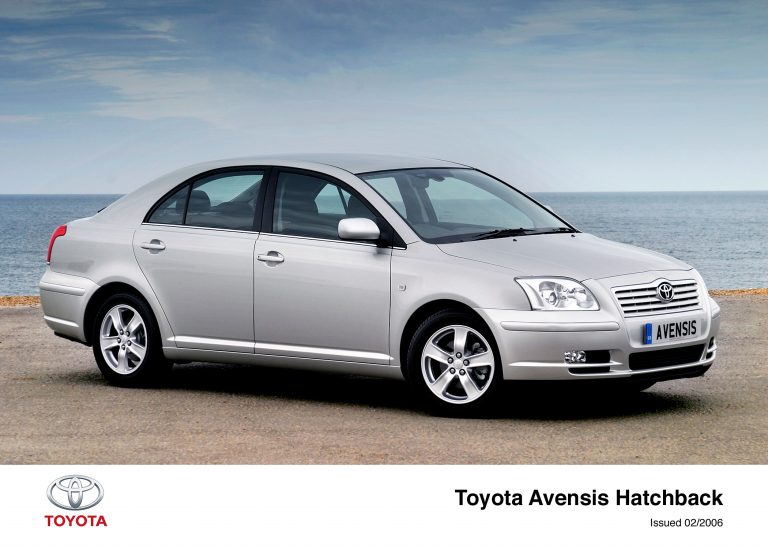The New Toyota Avensis 2.2 D-4D And 2.2 D-4D Clean Power
Effortless performance with superior quality
KEY POINTS
- Two new 2.2-litre D-4D engines for Toyota Avensis presented at the Geneva Motor Show
- 2.2 D-4D
- Maximum power 148bhp and 310Nm from 2,000 to 3,200rpm
- Lightweight all-aluminium construction
- New, compact six-speed manual transmission
- Targeted top speed of 130mph and 0-62mph in 9.3 seconds
- Targeted combined fuel consumption of 47.1mpg and CO2 emissions of 157g/km
- Available in the UK from June 2000
- 2.2 D-4D Clean Power
- On sale in the UK in early 2006
- Class-leading performance: 175bhp and 400Nm from 2,000 to 2,600rpm
- Combined fuel consumption on average 20 per cent lower than rival engines with similar output (target figure)
- Lighter than most engines in segment, 11 per cent lighter than current 2.0-litre D-4D unit
- World’s lowest compression ratio for a production diesel engine, 15.8:1, aiding quieter operation and better performance from start-up
- Electrically-activated turbocharger with turbine wheel inertia reduced by 30 per cent for quicker engine response
- Toyota D-CAT system makes engine the cleanest on the market for combined nitrogen oxides (NOx) and particulate matter (PM) emissions
- Class-leading cost of ownership profile
- Both engines produced in Poland by Toyota Motor Industries Poland (TMIP)
- Complete Avensis engine range remains Euro IV compliant
- Avensis driving dynamics improved with new suspension settings and NVH package
INTRODUCTION
The Avensis has been a hugely successful car for Toyota in Europe. Now its driver appeal is to be increased with the introduction of two new 2.2-litre D-4D diesel engines. These will give the Avensis one of the most comprehensive product ranges in the D segment with three diesel (2.0, 2.2 148bhp and 2.2 175bhp) and four petrol (1.6, 1.8, 2.0 and 2.4) units. They also build on the Avensis’s achievement of offering an engine range fully compliant with Euro IV emissions standards, right from day one.
The first of the two new diesels to reach the UK market will be a 148bhp 2.2 D-4D unit. This uses a second generation common rail system to help achieve an excellent balance of performance and economy. The engine’s preliminary performance figures show 0-62mph acceleration in 9.3 seconds and combined cycle fuel consumption of 47.1mpg.
The second phase of the new diesel engine development will come in early 2006 with the introduction in the UK of a 175bhp version of the 2.2 D-4D that will launch Toyota’s revolutionary new concept for diesel engines, Clean Power. Clean Power features some of the world’s most innovative diesel technologies, some of them unique to Toyota.
Thanks to the incorporation of Toyota D-CAT (Diesel Clean Advanced Technology), the 2.2 D-4D Clean Power has the lowest combined NOx and PM emissions of any production diesel engine. At the same time, the engine also offers segment-leading levels of power and torque, 175bhp and 400Nm between 2,000 and 2,600rpm; the lowest levels of noise, vibration and harshness (NVH); and on average 20 per cent lower fuel consumption than engines of equivalent power output (target combined fuel consumption for the saloon model is 46.3mpg).
The two engines are being introduced together in other European markets, but in the UK their launch is to be staggered with the more powerful 2.2 D-4D Clean Power engine set to join the Avensis range at a later stage in the model’s life cycle. This decision takes into account the particular market conditions for D segment diesels in this country and the different specification structure for UK Avensis models.
Both engines are being built by Toyota Motor Industries Poland (TMIP) at Toyota’s newest factory in Europe. Toyota invested €200 million (approximately £140 million) to create the facility in Jelcz-Laskowice, which has an annual capacity of 150,000 engines and a work force of around 500 people.
TOYOTA 2.2-LITRE D-4D ENGINE
The first of Toyota’s new 2.2 D-4D engines to arrive in the UK market will be the standard 148bhp unit, joining the established 114bhp 2.0 D-4D in the Avensis range. In common with all other engines, petrol and diesel, powering the Avensis, the new unit complies with Euro IV emissions standards.
Owners will reap big benefits in terms of performance, refinement and running costs. Preliminary data for the new engine indicate a 130mph top speed and nought to 62mph acceleration in 9.3 seconds, while targeted figures for combined cycle fuel consumption and carbon dioxide emissions are 47.1mpg and 157g/km (hatchback and saloon versions).
Toyota is pushing forward diesel engineering by adopting an all-aluminium construction for the 2.2 D-4D. The subsequent weight saving over the more conventional iron build design helps contribute to the engine’s strong performance profile.
In common with the more powerful 2.2 D-4D Clean Power, the engine is matched to a new six-speed manual transmission that is compact and offers smoother and more precise gear changes. More details about the engine construction and transmission are given below.
TOYOTA 2.2 D-4D CLEAN POWER
The new 2.2 D-4D Clean Power is lighter than most engines in its class (1.9 to 2.2-litre), thanks to its all-aluminium construction, something that is still rare among diesel engines. Clever engineering measures include integration of the water and oil pump on the chain cover, reducing the oil pump’s weight by five per cent and its volume by 20 per cent. This contributes to making the engine 11 per cent lighter overall than the Avensis’s 2.0-litre D-4D engine.
Further reductions have been made in noise and vibration by adopting a balancer shaft. This substantially reduces booming – by up to 10dB at higher revs.
The Clean Power engine also has the lowest compression ratio of any production diesel engine: 15.8:1. This means the piston requires less effort to compress the air-fuel mixture, something that has been made possible by the use of an advanced common rail injection system and improved ceramic glow plugs that operate at much higher temperatures than previous D-4D engines (up 100° C to 1,175° C), enabling more efficient cold starting. Combustion is quieter and there is less build-up of heat in the piston bowl for a more efficient burn and, in turn better fuel economy and lower emissions.
The new engine uses the same cylinder liner material as Toyota’s current 1.4-litre D-4D engine, which has already shown superior wear resistance and good adhesion to aluminium.
NEW INJECTION AND INDUCTION TECHNOLOGIES
Most current common rail systems use solenoid injectors, actuated by a magnetic field generated by an electric current. By contrast, the new 2.2 D-4D Clean Power engine uses piezoelectric technology, a first in its displacement class.
The principle behind this technology is the capacity of certain materials to deform when an electrical charge is applied and return to their original state when the current is removed. This concept is applied to the new engine, with each injector composed of a stack of piezoelectric ceramic elements. When an electric current is applied to the stack, the elements instantly expand, allowing the fuel from the common rail to be injected into the cylinder. This means more fuel can be injected in a shorter time than is possible with conventional injectors. This in turn leads to greater fuel atomisation and more precise injection timing.
There are many advantages to this system. For instance, the new piezoelectric injectors operate 10 times quicker than solenoids when producing an injection and can perform up to five injections per cycle, with a single pilot injection at hot idle and multiple injection at partial load. With piezoelectric technology, pilot injection can be optimised, substantially reducing combustion noise.
Toyota’s piezoelectric common rail system produces the highest injection pressure (1800 bar) and the highest number if injections per cycle of any system of its type. Toyota is the first manufacturer to bring this diesel technology to the mainstream car market, first in the Avensis and with other models to follow.
The 2.2 D-4D Clean Power engine uses an electrically activated Variable Nozzle Turbocharger (VNT). The vanes of the VNT are installed in turbine housing and change position according to the speed of the gas flow. Rather than being activated by a step motor, they are triggered directly by a direct-current electric motor. This lets the engine ECU perform more precise and progressive activation of the vanes, helping increase turbocharger efficiency. Vane activation can also take place at lower engine speeds, if necessary. Compared with the 2.0 D-4D engine, the turbine wheel intertia has been lowered by 30 per cent, by reducing the number of blades and their thickness. This contributes to much quicker response at low speeds.
WORLD-BEATING EMISSIONS CONTROL SYSTEM
The new 2.2 D-4D Clean Power engine uses the revolutionary Toyota D-CAT system, which renders the high-performance engine the cleanest diesel power unit in the world in terms of combined nitrogen oxides (NOx) and particulate matter (PM) emissions.
D-CAT features a Diesel Particulate NOx Reduction (DPNR) four-way catalyst, the only system in the world which simultaneously reduces NOx and PM via the combination of a NOx-reduction catalyst and a particulate filter.
Effective operation of the DPNR is controlled by the engine management system varying the air-fuel ratio in the exhaust gases. To do this a fifth injector, the Exhaust Port Injector (EPI), injects fuel into the exhaust gas flow at a critical moment, creating the right stoichiometric conditions for the DPNR catalyst to reduce harmful emissions.
NEW SIX-SPEED MANUAL TRANSMISSION
The 2.2 D-4D and 2.2 D-4D Clean Power engines are matched to a new six-speed manual transmission designed for quick and precise gear changes. A multi-cone synchroniser is used from first to fourth gears, which requires less force in the gear shift action. It uses a slide ball bearing in the selector lever shaft and fork shaft for high shift efficiency, as well as a shift guide plate which reduces the amount of free play after a shift has been made. Shift smoothness is also improved by a re-shaped mass damper.
The new transmission is robust and exceptionally compact, measuring 384mm long. This is smaller than other six-speed units with identical or even inferior torque capacity. The unit has a three-axis construction which permits a 20 per cent reduction in length compared to a two-axis configuration.
The lowest viscosity oil available for manual transmissions is used, which contributes to a one per cent reduction in fuel consumption. Using an oil separator reduces losses, due to oil agitation. The transmission also offers a wider gear range, more than 7.0:1.
CLASS-LEADING COST OF OWNERSHIP
Toyota targets the cheapest running costs in segment for the Avensis, making the car an excellent proposition for fleet operators. Avensis currently has the best insurance rating in the UK (Groups 7 to 12 across the range), thanks to repair costs that are more than 20 per cent less than the segment average (9mph impact test with 40 per cent offset).
The Avensis’s strong cost of ownership credentials will be further strengthened with the introduction of the new 2.2-litre D-4D engine, thanks to its class-leading performance and low emissions.
The 2.2 D-4D engine matches the 2.0-litre unit in terms of cumulative maintenance time after 60,000 miles at 4.2 hours – the lowest figure in the diesel D segment. The new engine also accepts mineral oil, which is cheaper than the synthetic or semi-synthetic oil required for some other engines.
The engine features both an automatic belt adjuster and hydraulic valve compensators, which means there is no need for belt tension or valve clearance adjustments to be made during the engine’s lifetime.
IMPROVEMENTS IN DRIVING DYNAMICS
Along with the installation of the new 2.2 D-4D engine, the Avensis has been given an upgraded NVH package. This features an acoustic windshield, thicker bonnet insulator and extra sound insulation components in the engine compartment. The thickness of the floor and tunnel silencers has also been increased.
These measures make the Avensis 2.2 D-4D Clean Power the best in its class for booming noise and vibration.
The spring rate of the front anti-roll bar has been increased by 20 per cent, reducing body roll. The damping force of the front shock absorbers has also been increased, giving a flatter ride, and the capacity of the power steering pump has been intensified to allow for a quicker steering response.
TOYOTA 2.2 D-4D AND 2.2 D-4D CLEAN POWER PRELIMINARY TECHNICAL SPECIFICATIONS
| ENGINE |
2.2 D-4D |
2.2 D-4D CLEAN POWER |
||
| Type |
In-line 4-cylinder with Variable Nozzle Turbocharger and intercooler |
|||
| Cylinder head material |
Aluminium |
|||
| Engine block material |
Aluminium |
|||
| Fuel type |
48 Cetane diesel (or more) |
|||
| Injection type |
Direct, common rail, multiple fuel injection |
|||
| Injection pressure (bar) |
1600 |
1800 |
||
| Emission control system |
Oxidation catalyst |
Toyota D-CAT + oxidation catalyst |
||
| Valve mechanism |
DOHC 16-valve |
|||
| Displacement (cc) |
2,231 |
|||
| Bore x stroke (mm) |
86.0 x 96.0 |
|||
| Compression ratio (:1) |
16.8 |
15.8 |
||
| Max. power (bhp/rpm) |
148@3,600 |
175@3,600 |
||
| Max. torque (Nm/rpm) |
310@2,000-3,200 |
400@2000-2600 |
||
| TRANSMISSION | ||||
| Drive type |
Front-wheel drive |
|||
| Gearbox type |
Six-speed manual |
|||
| PERFORMANCE | ||||
| Max. speed (mph) |
130 |
137 |
||
| 0-62mph (sec) |
9.3 |
8.6 |
||
| FUEL CONSUMPTION | ||||
| Combined* (mpg) | Saloon/hatch |
47.1 |
46.3 |
|
| Tourer |
47.1 |
45.6 |
||
| CO2 EMISSIONS | ||||
| Combined* (g/km) | Saloon/hatch |
157 |
161 |
|
| Tourer |
159 |
163 |
||
* According to Directive 1999/100/EC
ENDS






